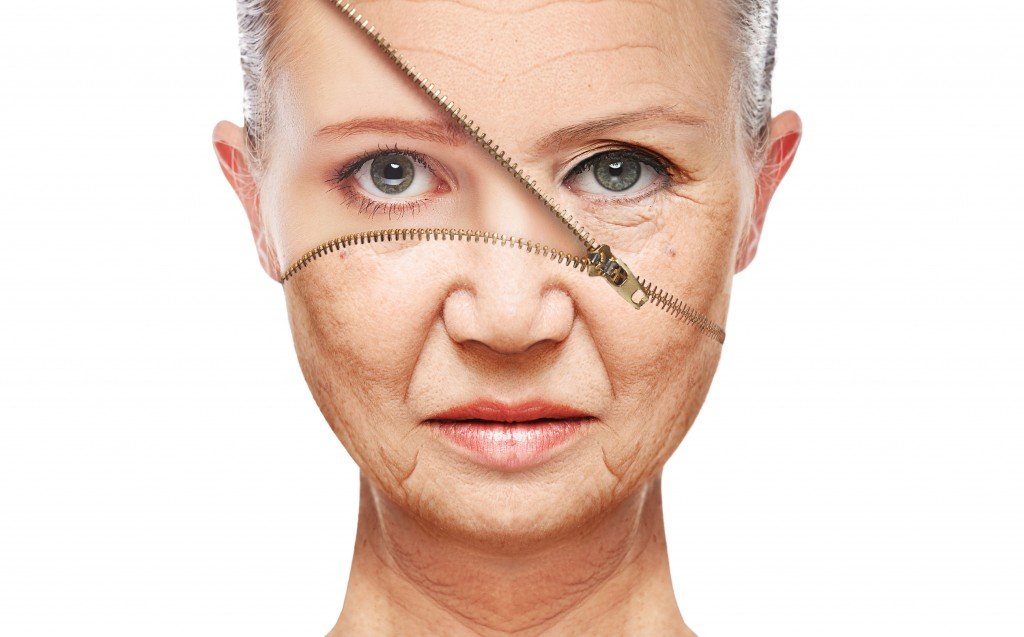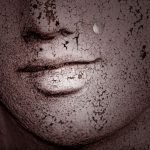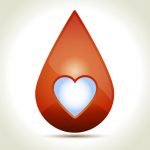Tolle Causam
Michael Rahman, BSc, ND
The use of autologous blood plasma injections is in keeping with the naturopathic principles of utilizing the body’s inherent powers and capacity for regulation and self-healing. Platelet-rich plasma (PRP) therapy is the ultimate biological skin rejuvenation treatment. It uses the patient’s own cells to refresh, tone, and tighten the complexion and provide overall rejuvenation by repairing the quality of the skin and restoring the plumpness to wrinkles, scarring, and crepey skin.
As NDs, we are well aware of the ability of techniques to work synergistically that lead us to better clinical outcomes with our patients. The healing process is initiated and activated with the introduction of PRP into the dermal tissue. We subsequently can apply radiofrequency (RF), which is the use of electromagnetic energy that stimulates the dermal and subdermal layers, to help us in remodeling to provide tightening and strengthening of the biological scaffolding or matrix, to relieve laxity of tissue. The following discussion will explore this synergistic application of plasma-rich therapy and the use of the physical therapy RF applied to the dermis, specifically for skin-tightening influences. Advances and the protocol for PRP will also be included.
Our therapeutic end point for skin tightening must take into consideration all of the following elements and treat the skin laxity for what could be considered a primary metabolic alteration as a result of cellular aging:
- Correction of cellular deficiencies and enzymatic stimulation
- Drainage of the connective tissue (matrix)
- Stimulation and support for the lymphatic and circulatory systems
- Structural or dermal strengthening and stimulation of neosynthesis of collagen (trophic stimulation); stopping or reversing collagen and elastin depletion
- Provision or reactivation of the inflammatory cascade to allow for
- tissue remodeling
PRP Review and Update
Platelets are an injury’s “first responders.” Under normal conditions, they release a variety of factors that initiate and subsequently stimulate bone, dermis, and cartilage regeneration and repair and promote new blood vessel development to accelerate tiss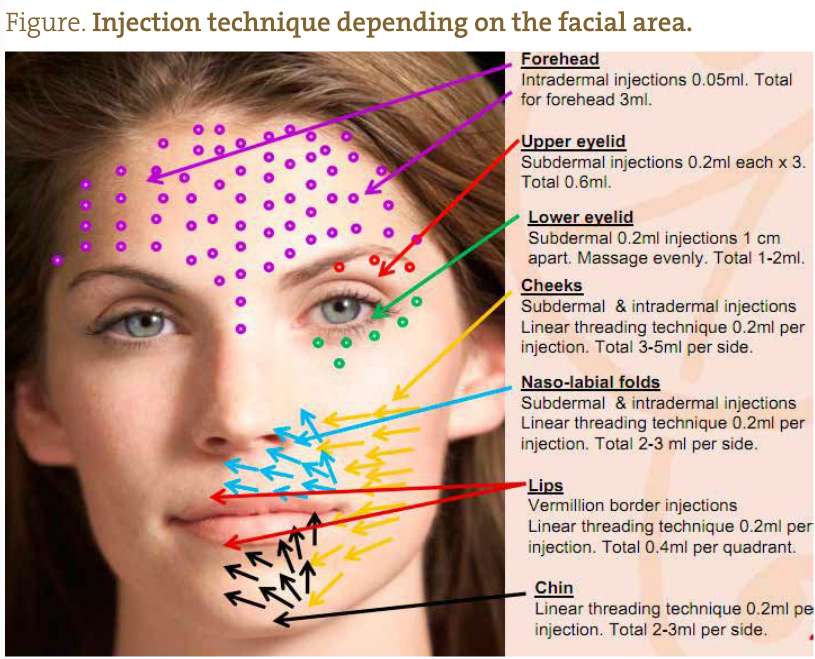 ue regeneration, thus decrease healing times. Platelets also release many other bioactive proteins responsible for chemoattraction of macrophages, mesenchymal stem cells, and osteoblasts.1
ue regeneration, thus decrease healing times. Platelets also release many other bioactive proteins responsible for chemoattraction of macrophages, mesenchymal stem cells, and osteoblasts.1
The growth factors and other cytokines present in platelets (released in the presence of thrombin or via activation by vibration, heat, stress, or calcium chloride) include the following:
- Platelet-derived growth factor
- Transforming growth factor
- Fibroblast growth factor
- Vascular endothelial growth factor
- Epidermal growth factor
- Keratinocyte growth factor
- Connective tissue growth factor
By enhancing the body’s natural healing capacity, PRP injection may lead to a more rapid, efficient, and thorough restoration of tissue to a healthy state.
Much discrepancy lies around the harvesting techniques and procedures in both concentrating and activating the platelets. Certainly, it is a sign that much more research is required in this domain. The platelet count is the first variable to be considered. Absolute platelet counts vary depending on the concentration in a subject’s peripheral blood. Depending on the device and kits utilized, the concentration can be increased from 2.5 to 9 times the baseline count. It seems that it would be intuitive to think that more is better; however, this does not seem to be the case, and some research suggests that higher than 2.5 times the baseline count might actually have inhibitory influences.2
It might be more advantageous to raise the concentration to slightly above native levels. It also seems that the PRP solutions containing white blood cells have different biological activity than PRP solutions in which white blood cells are absent. Depending on the separation system used, separations of blood can be made into 3 fractions, namely, the red blood cells, serum, and the buffy coat. It is the buffy coat that contains both platelets and white blood cells. So, the debate arises: should one include the white blood cell components?3
It is my clinical opinion that the inclusion of the white blood cells, neutrophils, monocytes and macrophages, and leukocytes can help in both balancing the proinflammatory and anti-inflammatory aspects of healing, as well as to elicit a matrix cleaning and remodeling influence. Therefore, my technique to harvest, concentrate, and activate the platelets has evolved to include the white blood cell components. This means that I begin by spinning the 8 mL of whole blood sample and separating into the red clot, serum, and buffy coat fractions, in less than 10 minutes. If using a specialized tube with patented additives, there can be a rise in the concentration to above physiological levels.4 Before extracting the PRP harvest, I gently agitate the buffy coat and draw up along with the platelet-poor plasma the white blood cell components. In healthy individuals, usually 5 mL is harvested per tube; to this I add 0.5 mL of calcium chloride for activation. This represents a ratio of one-tenth the total volume of PRP harvested after spinning. In consideration of the fact that collagen is a natural activator of platelets, I have also been including 0.5 mL of injectable homeopathic collagen 8X that I get compounded from my local compounding pharmacy. Usually, a total of 10 to 12 mL is required for a facial treatment. After activation, we have about 15 to 20 minutes to work with the solution without risking the solution’s becoming gel-like and more difficult to work with. Note that care is taken not to disrupt the platelets or create unintentional activation of platelets, so larger-bore needles are used for both extractions, from the blood tubes during harvesting and during injection into the patient. Typically, the harvest and extraction processes utilize a 21-gauge needle.5
Injections into the skin are strategized to work on all 3 layers of the skin, namely, the epidermal, dermal, and subdermal layers. This is so that the face not only looks more fresh and youthful but also is improved in the quality and texture. Injections are made using a 27-gauge half-inch (12 mm) needle. Injections on the face are made using intradermal injections, which means injecting up to 4-mm depth of penetration; subdermal or hypodermal injections require injecting deeper than 4 mm and up to 12 mm. A common injection strategy on the face is to use a linear threading or tunnel technique, especially to fill wrinkles or fine lines.
Epidermic stimulation can be achieved by spraying the PRP solution over skin or by using a very light-touch injection technique such as the mesotherapeutic nappage technique, which allows for 2-mm to 3-mm depth of penetration. The Figure summarizes injection techniques in the different facial zones. I have also been successful in using a deeper volumetric filling technique using a blunt-ended 27-gauge 1.5-in cannula, especially in the malar or midface region.
Once the activation has occurred at the injection site, the release of growth factors initiates the inflammatory response that lasts approximately 3 days.6 Fibroblasts accumulate and initiate the proliferative phase of healing that lasts several weeks. Subsequently, remodeling occurs to the collagen matrix that was laid down by the fibroblasts. It is almost as if we are building the scaffolding of collagen within the dermal tissues. This remodeling phase, which leads to the formation of mature tissue, lasts about 6 months. All phases are required for the new tissue to form and become stable. Over a few weeks, the platelets will stimulate the growth factors, which will assist in more collagen stimulation. Treatment results vary; however, the results last up to 18 months in most patients. Touch-up treatments biannually will maintain the results.
It is during this proliferative and remodeling phase that other therapies may be applied to aid in better clinical end points. The initiator of the healing process is activated with the PRP applied to the dermal tissue. We can next use RF to help us in the remodeling and to provide tightening and strengthening of the biological scaffolding.
Radiofrequency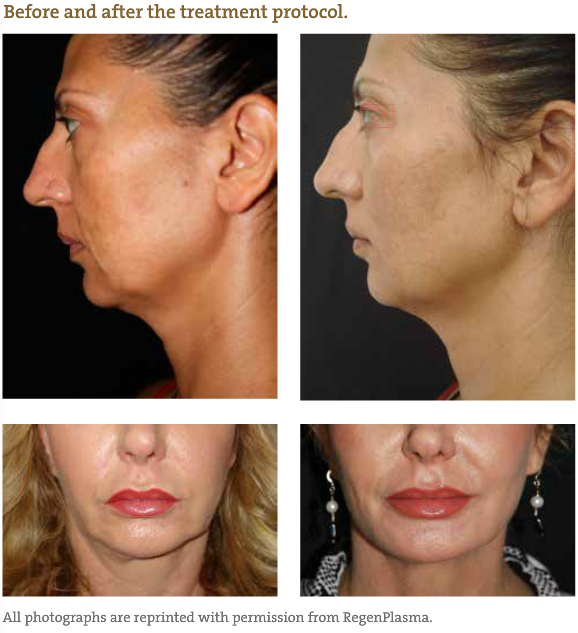
Radiofrequency is the use of low-frequency (<3 kHz) electromagnetic waves that stimulate bioelectric tissue activity, accelerating ion motion with a targeted and efficacious thermal effect. It uses the tissue’s resistance within the various layers of the skin to transform the RF energy into thermal energy. Many considerations are required for there to be successful transfer of the RF energy into thermal energy, including the size and depth of the tissue being treated, as one needs to consider the tissue impedance of the skin being treated. Since RF energy produces an electrical current instead of a light source (such as intense pulsed light), tissue damage can be minimized, and epidermal melanin is not damaged either. With this knowledge, RF energies can be used for patients of all skin types; that is, it is color blind and allows for different depths of penetration based on what is to be treated, allowing for ultimate collagen contraction and production of new collagen.7,8 Developments in this technology have made possible the selective delivery of energy to deep dermis and subdermal layers, while protecting the epidermis, especially by the use of bipolar headpieces. It is believed that the effect of the RF energy is to create skin tightening by causing collagen contraction and remodeling by the breaking and reconstituting of the disulfide bonds. Other effects include immediate vasodilatation and hyperemia for increased cellular oxygenation and metabolism and fibroblastic stimulation.9
The device I use in clinical practice delivers bipolar frequency of 0.5 MHz, which allows stimulation of the biological process through to the deep dermal levels, while still influencing the more subcutaneous levels. The immediate effect is that collagen and elastin fibers become contracted and denatured, and in the longer term, neocollagenesis occurs and an increase in the tensile strength of the collagen and elastin fibers. In a nutshell, RF helps to firm and compact the tissue. As a stand-alone treatment, RF can exhibit somewhat immediate effects in the allowance of moisturizing and hydrating influences, as well as a slight tightening effect. It is the stimulation of the deep dermal levels that takes more time to elicit a true clinical response. A treatment strategy for RF alone involves a protocol of anywhere from 8 to 10 treatments spaced 1 to 2 weeks apart. The results are subtle and not as dramatic as those in combination with the PRP.
Exposure of the dermal tissues to PRP solution can create a much more desirable and effective strategy for allowing the biological scaffolding of collagen and meshing proteins to form and become more stable. An entire treatment program of combination therapies may be strategized as follows for facial laxity and contour or wrinkles.
The PRP Protocol
Initially, the PRP protocol has a time lag of 3 weeks to allow for the activation, proliferative, and healing processes to ensue. Then follows a bipolar RF treatment. Wait 1 week, and then again perform PRP. This is done in this manner for a total of 3 PRP procedures and 3 RF treatments; the total duration is 3 months. Remember that, while results are noticeable within weeks, the true effect and judgment of our clinical outcome are not relevant until 6 months have passed. Using this technique, I have elicited excellent results and therapeutic end points on facial and neck contouring. I am currently conducting a small outcome study to demonstrate the satisfaction, safety, and effectiveness of this combined cosmetic protocol, with all the intricacies I have outlined throughout the article.
Conclusion
In summary, face and neck revitalization and rejuvenation with the synergistic application of PRP and the physical therapy RF as a combination technique represent a promising favorable protocol for the treatment of facial contour, skin texture, elasticity, tightening, and skin wrinkling.10 These individual techniques and the combination protocol are well tolerated, with low associated risks. The objective and subjective results and patient satisfaction are high, rendering this protocol a valuable clinical tool for use in naturopathic practice.
 Michael Rahman, BSc, ND is a naturopathic physician who has been in practice for 15 years and owns clinics in Toronto and Durham (Ontario, Canada). After completing his bachelor of science at McMaster University (Hamilton, Ontario), he attended the Canadian College of Naturopathic Medicine (Toronto). His practice focuses on biological medicine, healthy age management, and cosmetic medicine. The owner of Pinewood Institute for the Advancement of Natural Therapies (Toronto), he teaches NDs across North America about mesotherapy for pain management and cosmetic medicine, platelet-rich plasma for cosmetic care, and advanced homotoxicological approaches to treatment of disease. Dr Rahman can be reached at [email protected].
Michael Rahman, BSc, ND is a naturopathic physician who has been in practice for 15 years and owns clinics in Toronto and Durham (Ontario, Canada). After completing his bachelor of science at McMaster University (Hamilton, Ontario), he attended the Canadian College of Naturopathic Medicine (Toronto). His practice focuses on biological medicine, healthy age management, and cosmetic medicine. The owner of Pinewood Institute for the Advancement of Natural Therapies (Toronto), he teaches NDs across North America about mesotherapy for pain management and cosmetic medicine, platelet-rich plasma for cosmetic care, and advanced homotoxicological approaches to treatment of disease. Dr Rahman can be reached at [email protected].
References
- Marx RE, Carlson ER, Eichstaedt RM, et al. Platelet-rich plasma: growth factor enhancement for bone grafts. Oral Surg Oral Med Oral Pathol Oral Radiol Endod. 1998;85(6):638-646.
- Graziani F, Ivanovski S, Cei S, et al. The in vitro effect of different PRP concentrations on osteoblasts and fibroblasts. Clin Oral Implants Res. 2006;17(2):212-219.
- Harmon K, Hanson R, Bowen J, et al. Guidelines for the use of platelet rich plasma. Presented by the International Cellular Medical Society. Draft version 1.0. 2011. http://www.cellmedicinesociety.org/attachments/370_Section 10 – Platelet Rich Plasma (PRP) Guidelines.pdf. Accessed March 15, 2013.
- Discussions and training. RegenPlasma. Clarion Canada. http://www.clarionmedical.com/dermalfillers/regen_plasma.html. Accessed March 15, 2013.
- Rahman M. Platelet-rich plasma injection therapy training manual. Pinewood Institute for the Advancement of Natural Therapies. 2013. http://pinewoodinstitute.com/. Accessed March 15, 2013.
- Kumar V. Inflammation, healing and repair. In: Pathologic Basis of Disease. 7th ed. Philadelphia, PA: WB Saunders; 2005:76-86.
- Gold MH. Tissue tightening: a hot topic utilizing deep dermal heating. J Drugs Dermatol. 2007;6(12):1238-1242.
- Gold MH. The increasing use of nonablative radiofrequency in the rejuvenation of the skin. Expert Rev Dermatol. 2011;6(2):139-143.
- Molecular Beam Epitaxy Radiofrequency Equipment Training Module and Materials. Bologna, Italy: Maya Beauty Engineering, SRL; 2008. Handbook.
- Redaelli A, Romano D, Marcianó A. Face and neck revitalization with platelet-rich plasma (PRP): clinical outcome in a series of 23 consecutively treated patients.
- J Drugs Dermatol. 2010;9(5):466-471.

